When it comes to the wood found in and around the home, it is imperative to understand the different elements that can cause considerable damage. Rather than playing detective, it is helpful to know how to look at signs and understand what to do. Several different organisms can destroy your walls, flooring, and outdoor spaces. Therefore early identification allows you to react and resolve the issue immediately. This reactivity can save homeowners thousands of dollars in damage repair and general peace of mind. At first glance, termite damage and wood rot may seem the same, but further inspection will expose their differences. If left unidentified and untreated, both will cause severe structural damage, so we want to show you what to look for inside the home.
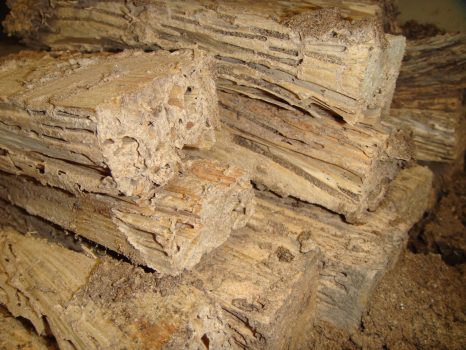
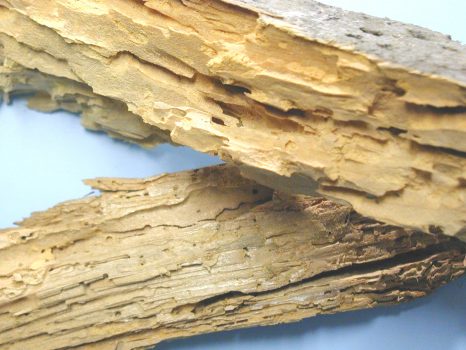
Knowing the difference
Whether the problem is termites or wood-decay fungi, each one has specific signs that can indicate their presence. The damaged wood they leave in their wake contains telltale signs that reveal who is to blame. Knowing what to look for can save you time and money and keep you from playing the guessing game. Like any unwelcome guests, these indicators are not always easy to spot but can help you over time. Working backward, let us look at the damage they cause and see how their habits and behaviors can lead you to them.
Although they may appear similar, termite damage and wood rot have a few differences that can help you tell them apart. Termites eat through the wood from the inside out, meaning that initial destruction may be hard to detect. Due to their attack methods, termite damage can make the wood look wavy. You may also notice their tunnels, which can look like sanded-down holes or as if random wood chunks are missing. The wood will sound hollow when tapped or knocked on with a hard object.
Dry rot, also called brown rot, is most commonly mistaken for termite damage and will darken the wood. As dry rot spreads, wood can develop a cracked, almost brick-like appearance. The damage may look similar to a termite infestation, though the patterns will not be as uniform and may be patchy. Dry rot may feel soft and spongy, causing the wood to crack and crumble. It is also usually more localized than termite damage. Dry rot will stay within an area with excess exposure to moisture.
Either way, once their presence becomes noticeable to the untrained eye, the damage is probably already excessive. In any case, MABI recommends contacting your local pest control or wood preservation professional to inspect and assess the damage. They will be able to give you an idea of the extent of the damage and how to proceed. To help, here are a few other signs that may indicate the presence of termites or wood-decay fungi.
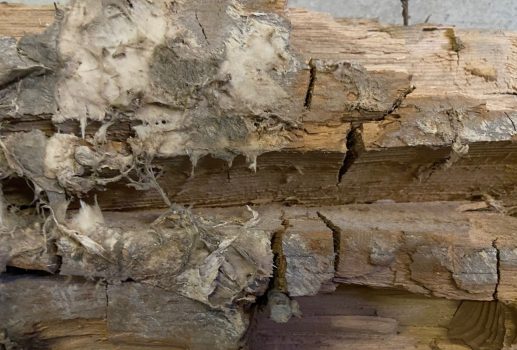
How to identify termites vs. wood decay fungi
Termites.
Termites can cost up to a few thousand dollars in repairs for a single home. Because most termites stay hidden inside the wood or travel in specific ways to remain undetected, you are unlikely to see them crawling around your house. Instead, there are distinct signs that indicate the presence of an active termite colony or, in some cases, an inactive one. Depending on the type of termite infesting your home, you can look for the following signs:
- Discarded wings. This sign is one of the first things you see that may indicate the presence of termites in your home. During swarming season, termite alates (termite swarmers) will fly the nest in an attempt to mate and begin a new colony. Once these termites land, they shed their wings before finding a suitable location to build their nest. You may find the discarded wings around closed windows and doors or on the floor. Take note: swarming season varies based on the location and type of termite. The season usually begins when the weather warms up or during the spring and summer.
→ True for all types of termites. Drywood swarmers lose their wings more quickly, so you are more likely to find them dead without their wings when compared to subterranean swarmers.
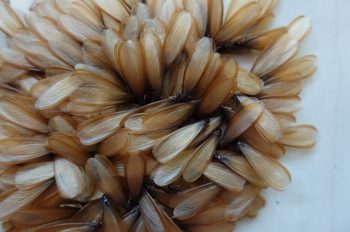
- Mud tubes. Another clear and visible sign of termites is the appearance of mud tubes, sometimes called shelter tubes or tunnels. Mud tubes are tunnels made by subterranean termites used to travel from their belowground nest to an aboveground food source. Since subterranean termites are susceptible to dehydration and require contact with a moisture source, these tunnels keep them hydrated, protecting them from desiccation and predators. Termites use soil, wood, and termite saliva to construct them, using these tunnels to travel along the basement and foundation walls.
→ True for all subterranean termites. Although mud tubes are found around the basement or foundation, you may find them in the upper levels.
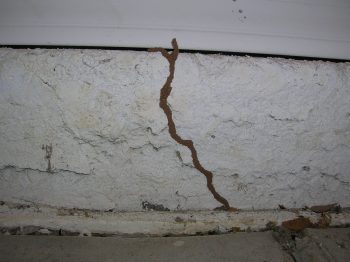
- Frass. Although it is easy to spot, it is still important to pay attention as frass can be created by more than just termites. Drywood termite frass is termite feces that look like sawdust, appearing in small piles near infested wood. As the termites move deeper into the wood, they remove the frass to make room inside. Although frass is typically indicative of an active infestation, this is not always the case. Frass can continue to exit the wood even once the infestation has been treated and becomes inactive.
→ True for drywood termites. Drywood termites can retain water from the wood they eat. As a result, they are less reliant upon a source of moisture and live within the wood they infest.
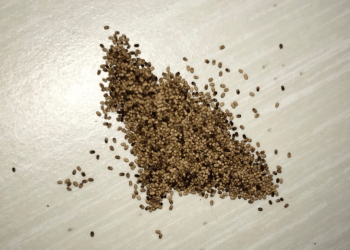
Wood rot.
As it attacks the wood from the outside inwards, wood rot can inflict significant structural damage to the home. As a result of one of several types of wood-decay fungi, wood rot weakens the wood by attacking the organic compounds that make it up. Like termites, wood rot generally remains undetected, growing slowly in spaces used less often, such as crawl spaces, attics, and basements. And just like termites, they may leave signs indicating their unwanted presence.
- Discoloration. Check the wood closely with a flashlight for any color changes. The color will vary depending on the type of wood rot attacking the wood. The color difference is due to the organic compound attacked within the wood. If you notice any discoloration, you should test the strength of the wood with a screwdriver. If the wood feels soft and breaks easily, this is usually a sign of wood rot.
→ Brown rot will cause wood to become darker in color. White Rot causes wood to take on a lighter or whiter. Soft rot may turn the wood darker or lighter in color.
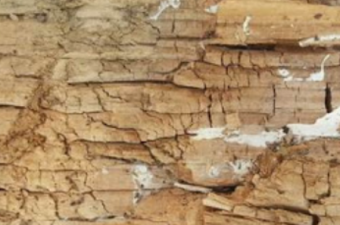
- Mold. Often confused for wood rot, mold is simply a surface fungus. While it does not decompose the wood as wood rot can, it may still indicate future wood rot. This fact is because, like wood rot, mold grows in areas with damp and humid environments. If left untreated, mold appears when the wood has absorbed too much water. This problem could ultimately lead to wood rot. The main difference is that mold tends to cause discoloration in the wood.
→ NB: If unsure, the screwdriver test can help you differentiate mold from wood rot because wood rot turns the wood soft. Take a screwdriver and press it into the suspected wood rot area. If it sinks in with little pressure, this is likely wood rot.
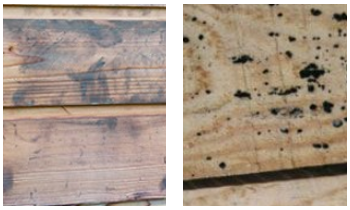
- Musty smell. Like mold and mildew, as the fungus breaks down the wood, wood rot will begin to give off a specific smell. This particular smell is musty and earthy. Of course, if you start to smell something funny, it does not necessarily mean it is wood rot. While this odor could be mold or mildew, you should still look into the problem. Much like the appearance of the mold itself, a musty smell typically means excess moisture and humidity, which can then cause mold and wood rot.
What are the causes?
Now that you know a little bit more about termites and wood rot, you may be wondering how they entered the home in the first place. The answer to both comes back to the same issue: wood with excess moisture. In most cases (except for drywood termites), wood with a high moisture content attracts these different organisms, inviting them to feed and grow. Due to a lack of ventilation, several places in the home are more likely to have humidity problems, such as basements, attics, and crawl spaces. However, this does not mean that termites and wood rot will only infest these spaces. Anywhere in the home where excess moisture has built up is susceptible to attack.
Both exhibit a preference for humidity accompanied by warmer temperatures. It is typical for termites and termite activity to slow down during the winter as they wait in their colonies for things to warm up. If temperatures stay too low for too long or snow covers the ground, a termite colony is unlikely to survive. This detail is why the southern half of the United States has so many termite problems, making Alaska the only safe state. As for wood rot, conditions need to be quite similar. Temperatures need to be between 50° and 100°F for wood rot to truly thrive, on top of the need for air, water, and food.
How to limit infestation and attack
No matter what organism attacks the home, it is wise to be aware of the possible signs surrounding you. It is imperative to protect the home when and where you can and look out for potential damage. Whether you are building your dream home or have been living in it for years, there are always steps to help prepare you. We’ve compiled a few ways to limit termite infestations or wood rot.
- Reduce moisture. Any sign of water leakage should be immediately inspected and repaired for potential wood damage. Do not forget to check around toilets, washing machines, and even refrigerators.
- Control humidity. Although you should pay special attention to enclosed, poorly ventilated spaces, this is pertinent anywhere in the house. It is best to ventilate when and where possible in areas with high humidity levels. Opening up nearby windows and doors can help regulate humidity levels. If this is not possible, try installing a dehumidifier or a fan to remove excess moisture from the air or create airflow.
- Wood treatment. Always treat any wood you wish you use inside or outside the home before installation. Staining, painting, or treating the wood protects it by creating a protective seal. Outdoor areas should be checked regularly as exposure to the elements can wear down treatments faster.
Now that you understand the difference between termite damage and wood rot make sure you perform routine checks to protect your home. Of course, if you are unsure about the presence of termites or wood-decay fungi or are looking to treat them, we recommend you contact a professional wood-preserving or damp-proofing company. It may also be possible for a mycology lab to help you identify the fungus species.